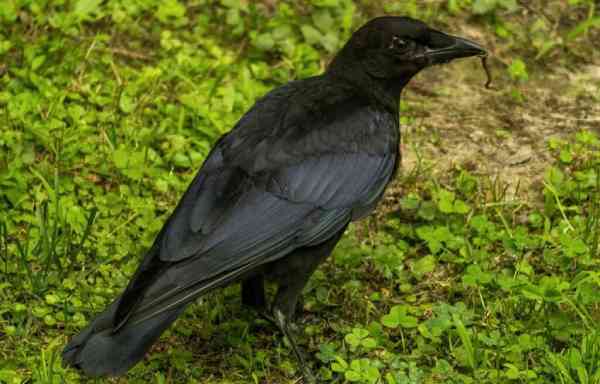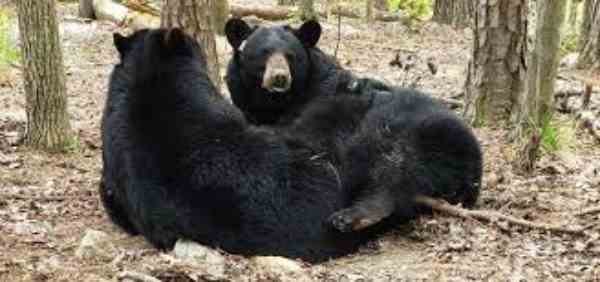The beauty of black is captivating and striking. According to colour psychologists, black embodies an aura of mystery and fascination, particularly noticeable in various black animals.
Table of Contents
Among all the colours present in nature, black stands alone as the only one not dependent on light reflection. From a technical perspective, black can be regarded not as a colour but as the absence of colour. This unique characteristic presents an intriguing aspect when studying animal biology, as most black animals possess an abundance of melanin, the colouring pigment.
Melanin, a natural pigment found in the majority of organisms, is responsible for providing colouration. There are various types of melanin, responsible for the diverse shades seen in different species. When melanin is lacking or deficient, it leads to albinism.
The type of melanin called eumelanin is responsible for black colouration in black animals. Mammals usually synthesize this melanin for their skin colour and protection against harmful solar radiation. On the other hand, insects demonstrate even more innovative uses of melanin, employing it for external pigmentation, exoskeletal hardening, healing, and immune responses.
It is important not to confuse black animals with melanistic animals. Melanism is a mutated condition characterized by excessive development of eumelanin in the skin and appendages, causing the animal to become entirely black and lose its natural species colouration.
Distinctions Between Black Animals And Melanistic Animals
Indeed, the distinction between black animals and melanistic animals is significant and worth noting. While both types may appear black, their underlying genetic makeup sets them apart.
Black animals are those whose species generally exhibit a predominantly dark colouration, and this colour is a typical characteristic of their kind. On the other hand, melanistic animals are individuals within a larger species who possess divergent pigmentation genes, resulting in their unique black appearance. For instance, the well-known black panther is not a distinct black feline species but rather a melanistic colour variant of the leopard and jaguar.
Despite their black colouration, melanistic animals share all other aspects of their behaviour and existence with other members of their species. Their hunting, feeding, mating, and reproductive behaviour remain consistent with the norms of their kind.
Upon closer inspection, you can observe that the rosette formation commonly seen in the fur of leopards and jaguars is still present in black panthers, although it may not be as easily visible from a distance. This subtle distinction helps differentiate them from naturally black creatures.
What Makes Black Animals Interesting?
It is a curious fact that black animals are not very common despite black being a practical colour for camouflage and aposematic colouration. Black can make an animal more difficult to spot, yet imposing at the same time. In fact, it has been thought that the reason why black is not more widespread in the natural world is that other colours may be more efficient for survival.
However, there is still a diverse range of animals that come to mind when we think about black animals, ranging from mammals to reptiles, birds, insects, and amphibians. Even though they may not be overtly colourful, the black animals always make an impression when we happen to spot one. This rarity is just another reason why they remain fascinating and mysterious to us.
1. Ravens

Ravens, belonging to the crow family, stand out as one of the largest birds. They can weigh up to 2kg, have a length of 67cm, and have an impressive wingspan of 150cm. These intelligent birds are highly adaptable, inhabiting diverse habitats across the globe. From the arctic and temperate regions in Europe, Asia, and North America, to the deserts of Saharan Africa and the isolated islands of the Pacific Ocean, ravens can be found in a wide range of environments.
Their jet-black colour has sparked various interpretations. While some cultures associate them with bad luck, others revere them as god-like emissaries, particularly in Scandinavian and Nordic folklore.
Ravens have gained a reputation for their exceptional intelligence. They have been observed fashioning basic tools using twigs and stones, a skill shared with some other members of the Crow family. Remarkably, ravens have been reported to display intelligence levels comparable to apes, fueling the fascination and myths surrounding them.
These sociable birds often travel in pairs or with flocks, maintaining excellent coordination. They quickly alert each other to the presence of predators, making them challenging prey. As a result, they generally face few natural predators, but their eggs and hatchlings are vulnerable to attacks from owls, eagles, and falcons.
Ravens, like other crow species, are omnivorous creatures. Their diet includes fruits, grains, acorns, and various small invertebrates, reptiles, and amphibians. They also scavenge for carrion when available, allowing them to sustain themselves with a diverse range of food sources.
2. Pilot Whales

Pilot whales earned their name from the belief that they were guided by a “pilot” leading their pods. These impressive cetaceans are appropriately called blackfish due to their black colouration. They rank among the largest sea dolphins, second only to orcas in size.
Within their genus, there are two living species: the short-finned pilot whale and the long-finned pilot whale. These two species are quite similar and have only minor distinguishing features. They occupy different but extensive ranges, covering various regions worldwide.
The long-finned pilot whales prefer colder waters, often found in polar regions of the North Atlantic and Southern Ocean. In contrast, the short-finned pilot whales inhabit temperate, tropical, and subtropical waters across the Indian, Atlantic, and Pacific oceans.
These social creatures thrive in pods containing 30 to 100 individuals. Working together, they hunt mainly for squids, forming strong social structures within their groups.
Interestingly, like humans and killer whales, female pilot whales experience menopause. This unique feature contributes to the species’ survival, as post-reproductive females can still lactate and assist in nursing the younger members of the pod.
Pilot whales are notorious for beach strandings, and the exact reasons behind this behaviour remain debated. Some researchers suggest that noise and water pollution may damage their innate echolocation system, leading to navigational issues. This tragic phenomenon was observed as recently as October 2022 when over 500 pilot whales were stranded and died off the coast of New Zealand.
3. Black Saddlebags Skimmer

The black saddlebag is a species of skimmer dragonfly native to North America. These dragonflies are commonly found near stagnant and slow-moving water bodies such as ponds and lakes.
They derive their name from their unique wings, which have distinctive black blotches, resembling saddlebags, giving them a striking appearance.
Though sizable insects, reaching a length of about 5cm, they are dwarfed by the giant Darner dragonflies, which can grow up to 13cm.
Like other dragonflies, they predominantly inhabit areas around water, where they engage in activities like feeding, mating, and laying eggs.
Black saddlebags primarily feed on tiny aquatic insects, including mosquitoes, water mites, and water lice. Their larvae also consume the larvae of these insects. Due to their efficiency in controlling mosquito populations, they have been intentionally introduced into certain ecological niches for this purpose. Both the adult and larval forms of these black animals contribute to effective mosquito management.
4. Bonobos

The Bonobo, an endangered ape species, is native to a small region of the Congo basin in the Democratic Republic of Congo, south of the Congo River. Genetically, they are our closest relatives among apes, sharing a remarkable 98.7% of their DNA with humans, along with chimpanzees.
Distinguishing them from their chimpanzee counterparts is their more agile and slender physique. They possess dark faces and a unique hair pattern on their heads that appears parted in the middle.
While Bonobos are primarily frugivorous, playing a crucial role in seed dispersion within the Congo rainforest, they occasionally supplement their diet with honey, eggs, and meat from invertebrates and rodents.
One of the most notable characteristics of Bonobos is their highly promiscuous behaviour, which is unparalleled in the animal kingdom and particularly among primates. In their society, sex serves various purposes, including bonding, conflict resolution, and strengthening relationships. Unlike most organisms, Bonobos engage in sexual activities for reasons beyond reproduction.
Interestingly, their relaxed approach to sex can lead to situations where both males and females engage in sexual interactions with members of the same gender, making them one of the few known species that exhibit homosexuality in the wild.
5. American Black Bear

The American black bear, often simply referred to as the black bear, is a medium-sized bear species found in the rainforests of North America. Its range extends from Alaska in the north, through Canada and the contiguous United States, down to Mexico in the south.
These black bears are closely related to the Asian black bear, as they share the characteristic jet-black colouration. However, one distinguishing feature is the absence of the white crescent blaze on their chests, which is typical of Asian black bears.
Being omnivores, American black bears have a diverse diet that includes grasses, fruits, fish, carrion, and small mammals. To avoid competition with larger and more aggressive bear species like the grizzly bear, they have adapted to occupy higher mountainous regions, with elevations reaching up to 9,800 feet. As a result, they have developed exceptional climbing abilities.
American black bears are remarkable survivalists, and their populations in the United States are estimated to number up to 500,000 individuals. This makes them the most populous bear species in the contiguous United States, showcasing their impressive ability to thrive in various environments.
6. Moneilema

The cactus longhorn beetle, known scientifically as Moneilema, is a genus of flightless beetles commonly recognized for their black colouration. They primarily feed on various types of cacti, such as the saguaro, cholla, and prickly pear cactus.
These beetles are native to the desert regions of the United States and Mexico, with a particular presence in the Sonoran Desert. The Moneilema genus includes around twenty species, each displaying its unique characteristics. However, all members of this genus share common traits, including their black appearance, fusiform hard exoskeletons, and long antler-like antennas.
Cactus growers often regard these beetles as pests due to the significant damage they can cause to cacti, even to large specimens like the saguaro or elephant cactus.
Interestingly, much of the damage inflicted on cacti is a result of the beetle larvae, rather than the adult beetles. These young beetles can penetrate the tough surfaces of the cactus plant, where they spend the winter, surviving by consuming the plant’s tissues until they reach adulthood in the spring.
As a consequence of the tissue damage caused by Moneilema larvae, it is not uncommon to witness cacti collapsing on themselves during the winter or spring. This damage can weaken and compromise the structural integrity of the cactus plant, leading to its collapse. Cactus growers often take measures to protect their plants from the detrimental impact of these beetles and their larvae.
7. Celebes Crested Macaque

The crested black macaque, also known as the crested macaque or black ape, is an old-world monkey species found exclusively in Indonesia, primarily inhabiting Sulawesi island, with some scattered populations on the neighbouring Bacan island. Due to their critically endangered status, many of these monkeys are housed in the Tangkoko Nature Reserve in Sulawesi, Indonesia, for conservation efforts.
The species derives its name from its native island, Sulawesi (formerly known as Celebes), and the distinctive black crest on its head. Apart from a few white hairs around their shoulders, they are entirely black, even around the face.
Despite being colloquially referred to as black apes, crested macaques are indeed monkeys. Their vestigial and barely visible tail gives them an appearance similar to apes. Like most monkeys, they are primarily frugivores, relying mainly on fruits for sustenance while occasionally supplementing their diet with eggs, insects, worms, and small vertebrates.
The social structure of these macaques is highly patriarchal, with groups often having a greater number of females compared to males, sometimes reaching a ratio of 4 to 1. This reduces competition among males for mates, and when young adults mature, they typically leave their birth group.
In 2014, Celebes crested macaques became the subject of a controversial debate regarding whether animals could own copyright. This discussion arose from a copyright lawsuit involving a selfie portrait taken by one of these macaques.
8. Ayam Cemani

The Ayam Cemani is a fascinating black animal originating from Indonesia, and it stands out as a unique breed of its own, unlike the other animals mentioned earlier which belong to specific genera or species. It is also the only domesticated animal on this list, and its distinct characteristics make it deserving of this distinction.
The Ayam Cemani is a chicken breed with a rare dominant gene that causes a condition called fibromatosis, a form of hyperpigmentation. Unlike melanism, which is typically a recessive trait, fibromatosis is dominant, leading to a more intense black colouration in the animal.
One of the most remarkable features of fibro melanistic animals, including Ayam Cemani, is that they are black to the bones. This means that not only their feathers, wattles, and beaks are black, but even their bones and internal organs have a black colour. However, their blood remains red, creating a striking contrast.
This condition of fibromatosis is found in only one other animal, the silkie, which is another chicken breed.
In the Indonesian islands where Ayam Cemanis are found, they are commonly used as gamecocks for cockfighting due to their thicker thigh muscles, which make them faster and more agile in such contests. Their unique appearance and desirable traits have also made them popular and sought after by chicken enthusiasts around the world.
9. Eastern Indigo Snake

The eastern indigo snake, despite its name, primarily displays a blue-black colouration on its dorsal scales, making it more of a black animal than indigo. However, when viewed up close, the iridescence of its scales gives them a dark shade of purple, which explains the name.
As the longest snake native to North America, the eastern indigo can reach impressive lengths of up to 9.2 feet. These snakes typically inhabit the southeastern corner of the United States, including states such as South Carolina, Florida, Georgia, Alabama, and Mississippi.
Although they are non-venomous, eastern indigo snakes are not constrictors like some other large snakes. Instead, they immobilize their prey by grabbing and beating it against a hard surface or swallowing it alive.
Despite being carnivores and feeding on eggs, mammals, fish, birds, and other snakes, these reptiles have a unique symbiotic relationship with the gopher tortoise. During the winter, they seek refuge in gopher tortoise burrows to keep warm. However, they do not prey on these tortoises, likely due to their size.
Interestingly, when approached by humans, these snakes often exhibit a gentle temperament. While they rarely attack when picked up, they may bite if they feel threatened. This mild disposition, combined with their captivating colours, makes them popular among reptile pet breeders and owners. However, it’s essential to note that keeping eastern indigo snakes as pets requires proper knowledge and care to ensure their well-being.
10. Ziegler’s Crocodile Newt

Ziegler’s crocodile newt is a fascinating species of crocodile newts that have only recently been discovered in Vietnam and the southern provinces of China. Although not much is known about them, we do know that they can grow up to three inches long and have a head that is much wider than most salamanders.
What makes these newts stand out is their unique black colour, with tiny orange stripes only on the tips of their toes and the underside of their tail. Many people are interested in their terrestrial behaviour and bizarre appearance, contributing to their growing popularity among amphibian enthusiasts.
As researchers continue to uncover more information about this peculiar species, there is no doubt that Ziegler’s crocodile newt will become an increasingly intriguing subject in the world of herpetology.
FAQs
Which animals are very black?
There are a variety of animals that are known for their deep black hue, showcasing both beauty and a sense of mystery. One well-known creature that comes to mind is the panther, with its elegant black coat and piercing yellow eyes.
However, there are many other animals that share this coloration such as the black bear, the black mamba snake, crows, and black panther moths. In some cases, the colouring may even serve as a survival adaptation, allowing these creatures to blend into their surroundings or appear more menacing to potential predators.
Which farm animal is black in Colour?
While their white woollen siblings may be more common, black sheep have been a fixture of the farm scene for centuries. Whether they are prized for their ornamental beauty or usefulness in the wool industry, these ebony-toned animals have a fascinating history that’s worth delving into.
What kind of animal is black and white?
Many people might first think of the zebra, a majestic animal found in Africa. Zebras have black and white stripes all over their body, which helps them to blend in with the tall grasses and avoid predators. Another example is the giant panda, which is native to China. Its black and white fur is a unique adaptation for camouflage in the snowy mountains where it lives.
Final Words
In conclusion, black animals are often overlooked due to superstitious beliefs and cultural biases. However, the melanistic trait that gives them their colouration, while rare, can be beneficial in concealing them from potential predators or prey.
From the graceful panther to the intelligent raven, black animals possess their own unique characteristics and should be appreciated for their individuality and resilience.
It is important to break down barriers and recognize the beauty in diversity, not just in animals but in all aspects of life. We must learn to appreciate and protect these creatures for future generations to enjoy.
Reference:
- https://pethelpful.com/wildlife/20-Black-and-White-Animals-Names-and-Pictures
- https://www.guinnessworldrecords.com/world-records/677430-darkest-animals
- https://www.theweathernetwork.com/en/news/nature/animals/photos-melanism-the-rare-condition-that-turns-animals-black
A motivated philosophy graduate and student of wildlife conservation with a deep interest in human-wildlife relationships, including wildlife communication, environmental education, and conservation anthropology. Offers strong interpersonal, research, writing, and creativity skills.










